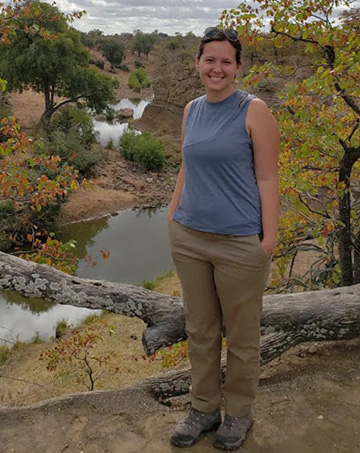
Study co-author Christina Ryder at a field site in South Africa. [Image: Christina Ryder; Sponheimer lab]
The term “archaeology” conjures up Hollywood visions of ancient treasure and priceless relics. But often, well-preserved skeletal remains constitute an archaeologist’s most valuable treasure for unearthing secrets of the past. Now, anthropologists at a U.S. university have devised a non-destructive method for prescreening old bones before time, effort and money are expended to prepare and analyze potentially unsuitable samples (Sci. Rep., doi: 10.1038/s41598-019-50443-2.)
According to the research team, its portable, rugged near-infrared (NIR) spectrometer can identify especially well-preserved bone samples based on their collagen content before they ever leave the archaeological site. That means that fewer of these precious specimens are exposed to destructive analysis.
Why collagen?
Bone collagen can resolve many anthropological dilemmas. The useful molecule can be used to date remains, identify dietary information and answer questions of human evolution—even after DNA evidence has decayed away. But collagen, too, degrades over time—and, depending on environmental factors that affect preservation, many ancient bones don’t contain much of it. As a result, researchers sometimes need to destructively sample a slew of bones to identify the prize few that are suitable for analysis, which creates an ethical and financial quandary.
Prescreening to determine which bones are most likely to reveal insights into the past, if done correctly, can help resolve some of those quandaries. But current prescreening methods are less than ideal; they involve taking small subsamples of a bone for elemental analysis to estimate the collagen preservation. Spectroscopic techniques such as mid-IR or Raman spectroscopy can be useful for prescreening, but they tend to be time-consuming and usually require transporting the fragile samples to a lab.
![]()
A bone fragment found in Serbia, dating back 25,000–45,000 years. [Image: Christina Ryder; Sponheimer lab]
Turning to NIR spectroscopy
To circumvent these limitations, researchers at the University of Colorado Boulder built on a previous study that used non-destructive NIR spectroscopy to classify bones from the Holocene epoch (11,700 years ago until present) as either good or poor collagen-preservation samples. The Boulder team took the idea of non-destructive NIR spectroscopic classification a few steps further—all the way to an archaeological field site.
The team designed a portable and field-ruggedized NIR spectrometer that can not only qualitatively sort samples by preservation status (good or poor), but can also quantify percent collagen preservation in Holocene to Late Pleistocene bones—up to tens of thousands of years old. In addition to the device’s portability, the briefcase-sized spectrometer returns results in mere seconds and has a greater effective penetration depth than its spectroscopic siblings. The technique’s speed means that researchers can potentially scan hundreds of samples at a site within the span of an afternoon. The penetration depth, meanwhile, could make the technique particularly useful for bones with contaminated or altered surfaces.
Estimating collagen preservation
As a proof of concept, the researchers prescreened 50 samples of ground-up ancient bone and 44 whole-bone fragments with known collagen concentrations. All samples were scanned with a fiber-optic reflectance probe attached to an NIR spectrometer with a spectral range of 350–2500 nm. After some clever data transformations and analyses, the team then carried out principal component analysis to ascertain whether the spectral data of the samples reflected any patterns related to collagen preservation.
The results, according to the team, confirmed that the 1695–1750 nm and 2000–2300 nm spectral bands were associated with collagen content. The team used these spectral data to successfully predict the approximate collagen concentrations within each sample, which ranged from 500 to 45,000 years old. The researchers also correctly sorted the bones into a “sample” group, containing more than 3% collagen, and a “do not sample” group, with less than 3% collagen.
The Boulder researchers then took their spectrometer on a high-profile test drive. They flew to Germany and, in collaboration with researchers from the Max Planck Institute for Evolutionary Anthropology, prescreened six vials filled with human-burial samples from a famous Czech Republic archaeological site. Upping the pressure, those six vials were the only site samples that anyone would have access to for the foreseeable future. With the help of the portable NIR spectrometer, the team was able to prescreen the valuable samples to find the best candidate for radiocarbon dating without compromising the remains.
The Boulder team hopes that, in the future, its fast, inexpensive NIR spectroscopic technique will help to save money, lab time and, most important, the integrity of samples that would otherwise be exposed to destructive analysis.
